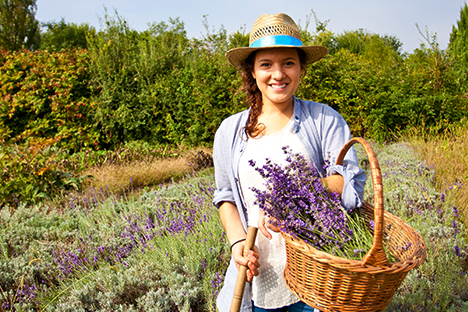BASIL
BOTANICAL NAME:Ocimum basilicum L.

PLANT DATA
| Common Name: | Basil |
| Botanical Name: | Ocimum basilicum L. |
| Family: | Lamiaceae |
| Origin: | Tropical regions of Asia and Africa |
| Other names: | ES: Albahaca FR: Basilic DE: Basilikum |


An annual herbaceous plant, with erect and quadrangular stems, variously branched, rich with ovate leaves. The upper side of the blade is dark green in color while the underneath is grey-green. The flowers are usually white or greenish, arranged in a spike at the axil of the leaves. It flowers from May to September. The entire plant is very aromatic.
OTHER SPECIES:
There are many species of basil that are valued for their culinary uses, and also for their medicinal applications. For example:
- Ocimum minimum: Small leaf basil
- Ocimum sanctum: Holy basil
Both above species are native to India.
- Ocimum kilimanjaricum: Camphorated basil from east Africa, but harvested also in India
- Ocimum viride: So-called “fever plant” or Tea of Gambia or of Sierra Leone, native to west Africa
The most commonly used varieties for extraction of essential oil are common or French basil and exotic basil. The latter is classified as being botanically identical to French basil (Ocimum basilicum L.), even if it is a bigger plant with a more acrid smell and different constituents.
ESSENTIAL OIL
The essential oil is obtained from the leaves when they bloom through steam current distillation. As the basil leaves are very delicate, the extraction of the essential oil can also be done through hydro distillation. This is a more delicate extractive technique suitable for delicate plant material such as leaves and flowers. The parts of the plants used for extraction are the leaves and the floral tops. The yield of essential oil is, on average, 0,3-0,5%.
TINCTURE
It is obtained by leaving the fresh aerial part of the plant to macerate in a hydro alcoholic solution with and alcohol content of 65 proof.
Climate and soil:
Basil is cultivated in all Europe and in the Mediterranean area and it prefers mild and temperate climates. It is a very demanding plant that grows well in sunny, well drained, medium textured soil; with a good availability of organic substance.
Planting and propagation:
Propagation by seed is the main method for Basil. The sowing is carried out during the Spring (March) in the nursery, where the temperature should be of at least 16°C. Seedlings are then transplanted around April/May. It is also possible to sow directly in the field in the same period, in a vase or on a properly prepared soil.
Crop duration:
Basil crops generally lasts one year.
Cultivation care:
To make the growing cycle last more it is necessary to cut off the flowering tops. After the flowering, in fact, the leaves lose most or their aroma. The organic substance is provided in the form of mature manure, buried while working the soil.
During the cultivation period hoeing and weeding are necessary, in order to aerate the soil and reduce the growth of weeds.
Basil also needs a good water supply, always avoiding water stagnation.
Harvesting:
Flowering tops and leaves with their petioles are harvested progressively, starting from Summer until the first Autumn frosts.
Most of the Basil cultivated is destined for fresh leaf utilization in the food industry and for pesto production. For this reason, after cutting the tops, another cut is made to remove the woody stems and facilitate the resprouting.
In mild climates, for example in Italy, it is possible to carry out 3 or 4 cuts during the Summer.
In warmer climates up to 8 cuts can be done.
Part of the plant used:
Upper parts
Properties and uses:
Basil is known mainly as an aromatic and seasoning plant. Leaves possess digestive properties.
Basil was traditionally used in herbal medicine as a tonic, especially against chronic fatigue.
The herbal infusion is recommended after meals for its antispasmodic and stomachic effects.
(be careful: Basil should not be consumed for long periods since there are no clinical or pharmacological studies to sustain its complete non-toxicity)
The utilization of basil leaves as a seasoning is important not only because of the good taste and the digestive properties, but also because of its content in antioxidants (for example rosmarinic acid in the leaves), which can counteract the effects of free radicals-induced cellular damage.
The essential oil exhibits antiseptic, expectorant and fluidifying properties, since it is eliminated via the bronchial mucous membrane.


